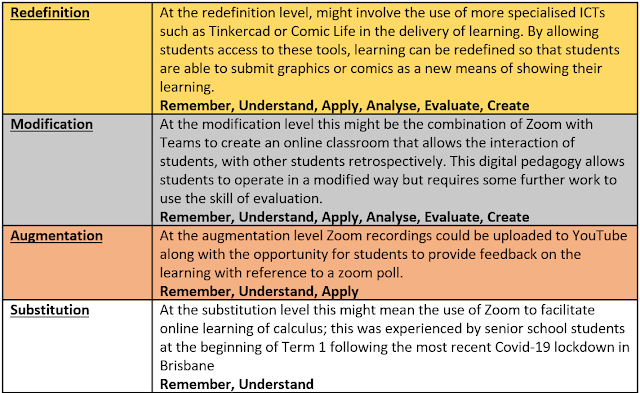SAMR Model
SAMR (substitution, augmentation, modification, redesigning) is a model for designing and reflecting on units that utilise technology and is used from the outset and throughout this blog. As shown in the image below, the SAMR model (Puendetura, 2013) is a four-tier hierarchy of learning developments which adopt technology rather that just traditional learning. Initially these are grouped in to enhancement and transformation; separated between augmentation and modification as shown in figure 1. At the augmentation level you are reproducing what you were doing before in your practice while at the modification level you are significantly modifying it and only keeping the core of the matter. This is further explained below.
Figure 1.
The 4 Levels of SAMR:
Adapted by Sockalingam & Liu, 2020 from Puentedura, 2012. Source: https://www.researchgate.net/publication/344971896_Designing_learning_experiences_for_online_teaching_and_learning/download
Starting at the lowest level, learning can be enhanced by technology through substitution. Substitution is the use of technology to replace learning that that would occur though manual modes such as reading of text books, writing on worksheets and presenting in front of a physically present audience. An relevant example of this might be the use of Zoom (2022) to facilitate online learning, like that experienced by senior school students at the beginning of Term 1 following the most recent Covid-19 lockdown in Brisbane as shown in figure 2. Moving up, Augmentation is the use of technology to augment, or differ learning slightly to allow an adjustment. Using the previous example, this might be the uploading of Zoom recordings to a class YouTube channel along with the opportunity for students to provide feedback on the learning with reference to a zoom poll.
Stepping up again is Modification; the significant change of learning such that it becomes a impossible without technology. Adding to the previous example, this might be the combination of Zoom with Teams (2022) to create a online classroom that allows the interaction. This ASOT pedagogy (Marzano, 2017) allows students to operate in a modified way which requires feedback from the teacher AND peers retrospectively, creating different and deep gateways between social knowledge. Finally, at its highest level, learning can be transformed by technology through complete redefinition. Redefinition of learning might involve the use of more specialised ICTs such as Tinkercad (2022) or Comic Life (plasq, 2022) in the delivery of learning. By allowing students access to these tools, learning can be redefined so that students are able to submit graphics or comics as a new means of showing their learning and redefines the assessment.
Figure 2.
SAMR in action:
Importantly, increased consideration of this model when evaluating teaching strategies enabled by ICT means greater insights developed around the transformative power of these technologies. For more examples, watch the interview with Puentedura (2016) below.
References:
Marzano, R. (2017). The new art and science of teaching: More than fifty new instructional strategies for academic success. Solution tree.
plasq. (2022). Comic Life. https://plasq.com/
Puentedura, R. (2013). SAMR: Moving from enhancement to transformation.
Puentedura, R. (2016). How to Apply the SAMR Model with Ruben Puentedura [Video]. Common
Sense Education. YouTube. https://www.youtube.com/watch?v=ZQTx2UQQvbU
Sockalingam, N., & Liu, J. (2020) Designing learning experiences for online teaching and learning.
Research Gate.
Teams. (2022). Microsoft teams group chat software.
https://www.microsoft.com/en-au/microsoft-teams/group-chat-software/
TinkerCad. (2022). Tinkercad: From mind to design in minutes. Autodesk. https://www.tinkercad.com/
Zoom. (2022). Video conferencing, cloud phone, webinars, chat, virtual events. https://zoom.us/
%20Sockalingam%20&%20Liu.png)


Comments
Post a Comment